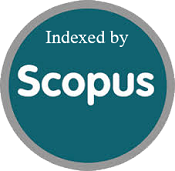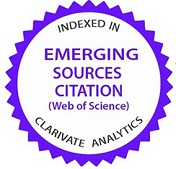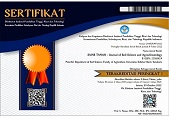Removal of glyphosate on Inceptisols ameliorated with biochar derived from young coconut waste
Abstract
Young Coconut Waste Biochar (YCWB) serves as an ameliorative agent that enhances soil quality and facilitates glyphosate removal, particularly in Inceptisols. This study aimed to evaluate the capacity of Inceptisols enhanced with YCWB to eliminate glyphosate, a commonly used herbicide. Inceptisols amended with 40 t ha⁻¹ YCWB demonstrated an increased surface charge, improving soil properties such as acidity (pH), electrical conductivity (EC), cation exchange capacity (CEC), and soil organic matter (SOM). The adsorption capacity was determined to be 0.87 mg g⁻¹ (or 870.27 mg kg⁻¹) at pH 5.07, under a glyphosate concentration of 100 mg L⁻¹. Glyphosate removal was facilitated by changes in functional groups, as indicated by Fourier-transform infrared spectroscopy (FT-IR), which showed reduced transmittance of O-H, C=C, C-O, C-H, and mineral groups. These modifications indicate an enhancement in the sorption capacity of Inceptisols treated with 40 t ha⁻¹ YCWB. The glyphosate adsorption isotherms followed the sequence: Langmuir > Freundlich model, with performance ranking as soil + 40 t ha⁻¹ YCWB > unamended soil (Inceptisols). The respective R² values were R² = 0.9889 > R² = 0.9739 for the Langmuir model and R² = 0.9953 > R² = 0.9099 for the Freundlich model, confirming a strong interaction relationship (R² > 0.9). This indicates that glyphosate removal occurs through simultaneous or alternating physical and chemical processes. Modifying the surface charge of Inceptisols using biochar-based amelioration technology derived from biomass waste, such as young coconut waste, is critical for improving glyphosate removal efficiency.
Keywords
Full Text:
PDFReferences
Adeyemo, A. A., Adeoye, I. O., & Bello, O. S. (2017). Adsorption of dyes using different types of clay: a review. Applied Water Science, 7(2), 543-568. https://doi.org/10.1007/s13201-015-0322-y
Ahmad, M. F., Ahmad, F. A., Alsayegh, A. A., Zeyaullah, M., AlShahrani, A. M., Muzammil, K., . . . Hussain, S. (2024). Pesticides impacts on human health and the environment with their mechanisms of action and possible countermeasures. Heliyon, 10(7), e29128. https://doi.org/10.1016/j.heliyon.2024.e29128
Ai, D., Tang, Y., Yang, R., Meng, Y., Wei, T., & Wang, B. (2023). Hexavalent chromium (Cr(VI)) removal by ball-milled iron-sulfur @biochar based on P-recovery: Enhancement effect and synergy mechanism. Bioresource Technology, 371, 128598. https://doi.org/10.1016/j.biortech.2023.128598
Ali, L., Palamanit, A., Techato, K., Chowdhury, M. S., & Phoungthong, K. (2021). Characteristics and agrarian properties of biochar derived from pyrolysis and co-pyrolysis of rubberwood sawdust and sewage sludge for further application to soil improvement. Research Square, 1-33. https://doi.org/10.21203/rs.3.rs-830242/v1
Ali, L., Palamanit, A., Techato, K., Ullah, A., Chowdhury, M. S., & Phoungthong, K. (2022). Characteristics of Biochars Derived from the Pyrolysis and Co-Pyrolysis of Rubberwood Sawdust and Sewage Sludge for Further Applications. Sustainability, 14(7), 3829. https://doi.org/10.3390/su14073829
Ayawei, N., Ebelegi, A. N., & Wankasi, D. (2017). Modelling and Interpretation of Adsorption Isotherms. Journal of Chemistry, 2017(1), 3039817. https://doi.org/10.1155/2017/3039817
Chilev, C., Dicko, M., Langlois, P., & Lamari, F. (2022). Modelling of Single-Gas Adsorption Isotherms. Metals, 12(10), 1698. https://doi.org/10.3390/met12101698
Costas-Ferreira, C., Durán, R., & Faro, L. R. F. (2022). Toxic Effects of Glyphosate on the Nervous System: A Systematic Review. International Journal of Molecular Sciences, 23(9), 4605. https://doi.org/10.3390/ijms23094605
Domingues, R. R., Sánchez-Monedero, M. A., Spokas, K. A., Melo, L. C. A., Trugilho, P. F., Valenciano, M. N., & Silva, C. A. (2020). Enhancing Cation Exchange Capacity of Weathered Soils Using Biochar: Feedstock, Pyrolysis Conditions and Addition Rate. Agronomy, 10(6), 824. https://doi.org/10.3390/agronomy10060824
Du, X., Lin, Z., Zhang, Y., & Li, P. (2023). Microstructural tailoring of porous few-layer graphene-like biochar from kitchen waste hydrolysis residue in molten carbonate medium: Structural evolution and conductive additive-free supercapacitor application. Science of The Total Environment, 871, 162045. https://doi.org/10.1016/j.scitotenv.2023.162045
El Zrelli, R., Yacoubi, L., Wakkaf, T., Castet, S., Grégoire, M., Mansour, L., . . . Rabaoui, L. (2021). Surface sediment enrichment with trace metals in a heavily human-impacted lagoon (Bizerte Lagoon, Southern Mediterranean Sea): Spatial distribution, ecological risk assessment, and implications for environmental protection. Marine Pollution Bulletin, 169, 112512. https://doi.org/10.1016/j.marpolbul.2021.112512
Galicia-Andrés, E., Tunega, D., Gerzabek, M. H., & Oostenbrink, C. (2021). On glyphosate–kaolinite surface interactions. A molecular dynamic study. European Journal of Soil Science, 72(3), 1231-1242. https://doi.org/10.1111/ejss.12971
Herviyanti, H., Maulana, A., Lita, A. L., Prasetyo, T. B., Monikasari, M., & Ryswaldi, R. (2022). Characteristics of inceptisol ameliorated with rice husk biochar to glyphosate adsorption. Sains Tanah Journal of Soil Science and Agroclimatology, 19(2), 11. https://doi.org/10.20961/stjssa.v19i2.61614
Jagadeesh, N., & Sundaram, B. (2023). Adsorption of Pollutants from Wastewater by Biochar: A Review. Journal of Hazardous Materials Advances, 9, 100226. https://doi.org/10.1016/j.hazadv.2022.100226
Jia, D., Liu, M., Xia, J., & Li, C. (2020). Effective removal of aqueous glyphosate using CuFe2O4@biochar derived from phragmites. Journal of Chemical Technology & Biotechnology, 95(1), 196-204. https://doi.org/10.1002/jctb.6221
Khadem, A., Raiesi, F., Besharati, H., & Khalaj, M. A. (2021). The effects of biochar on soil nutrients status, microbial activity and carbon sequestration potential in two calcareous soils. Biochar, 3(1), 105-116. https://doi.org/10.1007/s42773-020-00076-w
Kumari, K. G. I. D., Moldrup, P., Paradelo, M., Elsgaard, L., & de Jonge, L. W. (2016). Soil Properties Control Glyphosate Sorption in Soils Amended with Birch Wood Biochar. Water, Air, & Soil Pollution, 227(6), 174. https://doi.org/10.1007/s11270-016-2867-2
Lita, A. L., Maulana, A., Yulnafatmawita, Gusmini, Herviyanti, & Ryswaldi, R. (2022). Characteristics Biochar from Young Coconut Waste based on Particle Size as Améliorant. IOP Conference Series: Earth and Environmental Science, 959(1), 012034. https://doi.org/10.1088/1755-1315/959/1/012034
Maggi, F., la Cecilia, D., Tang, F. H. M., & McBratney, A. (2020). The global environmental hazard of glyphosate use. Science of The Total Environment, 717, 137167. https://doi.org/10.1016/j.scitotenv.2020.137167
Maulana, A., Herviyanti, Prasetyo, T. B., Harianti, M., & Lita, A. L. (2022). Effect of Pyrolysis Methods on Characteristics of Biochar from Young Coconut Waste as Ameliorant. IOP Conference Series: Earth and Environmental Science, 959(1), 012035. https://doi.org/10.1088/1755-1315/959/1/012035
Murtaza, G., Ahmed, Z., Eldin, S. M., Ali, B., Bawazeer, S., Usman, M., . . . Tariq, A. (2023). Biochar-Soil-Plant interactions: A cross talk for sustainable agriculture under changing climate [Review]. Frontiers in Environmental Science, Volume 11 - 2023. https://doi.org/10.3389/fenvs.2023.1059449
Muslim, R. Q., Kricella, P., Pratamaningsih, M. M., Purwanto, S., Suryani, E., & Ritung, S. (2020). Characteristics of Inceptisols derived from basaltic andesite from several locations in volcanic landform. Sains Tanah Journal of Soil Science and Agroclimatology, 17(2), 7. https://doi.org/10.20961/stjssa.v17i2.38221
Nayak, A., Bhushan, B., & Kotnala, S. (2024). Chapter 3 - Fundamentals and mechanism of adsorption. In M. Hadi Dehghani, R. R. Karri, & I. Tyagi (Eds.), Sustainable Remediation Technologies for Emerging Pollutants in Aqueous Environment (pp. 29-62). Elsevier. https://doi.org/10.1016/B978-0-443-18618-9.00002-4
Ogunbiyi, O. D., Akamo, D. O., Oluwasanmi, E. E., Adebanjo, J., Isafiade, B. A., Ogunbiyi, T. J., . . . Oladoye, P. O. (2023). Glyphosate-based herbicide: Impacts, detection, and removal strategies in environmental samples. Groundwater for Sustainable Development, 22, 100961. https://doi.org/10.1016/j.gsd.2023.100961
Patocka, J. (2018). Is Glyphosate Really Hazardous for Human Health? Military Medical Science Letters, 87(4), 169-183. https://doi.org/10.31482/mmsl.2018.030
Pereira, H. A., Hernandes, P. R. T., Netto, M. S., Reske, G. D., Vieceli, V., Oliveira, L. F. S., & Dotto, G. L. (2021). Adsorbents for glyphosate removal in contaminated waters: a review. Environmental Chemistry Letters, 19(2), 1525-1543. https://doi.org/10.1007/s10311-020-01108-4
Preocanin, T., Abdelmonem, A., Montavon, G., & Luetzenkirchen, J. (2016). Charging Behavior of Clays and Clay Minerals in Aqueous Electrolyte Solutions — Experimental Methods for Measuring the Charge and Interpreting the Results. In G. M. M. Do Nascimento (Ed.), Clays, Clay Minerals and Ceramic Materials Based on Clay Minerals. IntechOpen. https://doi.org/10.5772/62082
Sabran, S. H., & Abas, A. (2021). Knowledge and Awareness on the Risks of Pesticide Use Among Farmers at Pulau Pinang, Malaysia. SAGE Open, 11(4), 21582440211064894. https://doi.org/10.1177/21582440211064894
Şenol, Z. M., & Şimşek, S. (2020). Removal of Pb2+ ions from aqueous medium by using chitosan-diatomite composite: equilibrium, kinetic and thermodynamic studies. Journal of the Turkish Chemical Society Section A: Chemistry, 7(1), 307-318. https://doi.org/10.18596/jotcsa.634590
Sidoli, P., Baran, N., & Angulo-Jaramillo, R. (2016). Glyphosate and AMPA adsorption in soils: laboratory experiments and pedotransfer rules. Environmental Science and Pollution Research, 23(6), 5733-5742. https://doi.org/10.1007/s11356-015-5796-5
Singh, B., Camps-Arbestain, M., & Lehmann, J. (2017). Biochar: a guide to analytical methods. Csiro Publishing. https://www.publish.csiro.au/book/7478/
Tan, Z., Yuan, S., Hong, M., Zhang, L., & Huang, Q. (2020). Mechanism of negative surface charge formation on biochar and its effect on the fixation of soil Cd. Journal of Hazardous Materials, 384, 121370. https://doi.org/10.1016/j.jhazmat.2019.121370
Tévez, H. R., & Afonso, M. d. S. (2015). pH dependence of Glyphosate adsorption on soil horizons. Boletín de la Sociedad Geológica Mexicana, 67(3), 509-516. https://doi.org/10.18268/BSGM2015v67n3a13
Tzanetou, E. N., & Karasali, H. (2022). A Comprehensive Review of Organochlorine Pesticide Monitoring in Agricultural Soils: The Silent Threat of a Conventional Agricultural Past. Agriculture, 12(5), 728. https://doi.org/10.3390/agriculture12050728
Wetzel, F., Braun, T., Schindler, T., & Habekost, A. (2021). Rapid and Sensitive Electrochemical, Spectroscopic and Spectroelectrochemical Detection of Glyphosate and Glufosinate and Their Copper Salts with Screen-printed Electrodes. World Journal of Chemical Education, 9(4), 152-162. https://doi.org/10.12691/wjce-9-4-8
Yang, X., Muhammad, T., Bakri, M., Muhammad, I., Yang, J., Zhai, H., . . . Wu, H. (2020). Simple and fast spectrophotometric method based on chemometrics for the measurement of multicomponent adsorption kinetics. Journal of Chemometrics, 34(8), e3249. https://doi.org/10.1002/cem.3249
Zhang, P., Duan, W., Peng, H., Pan, B., & Xing, B. (2022). Functional Biochar and Its Balanced Design. ACS Environmental Au, 2(2), 115-127. https://doi.org/10.1021/acsenvironau.1c00032
Zhelezova, A., Cederlund, H., & Stenström, J. (2017). Effect of Biochar Amendment and Ageing on Adsorption and Degradation of Two Herbicides. Water, Air, & Soil Pollution, 228(6), 216. https://doi.org/10.1007/s11270-017-3392-7
Refbacks
- There are currently no refbacks.











.png)





